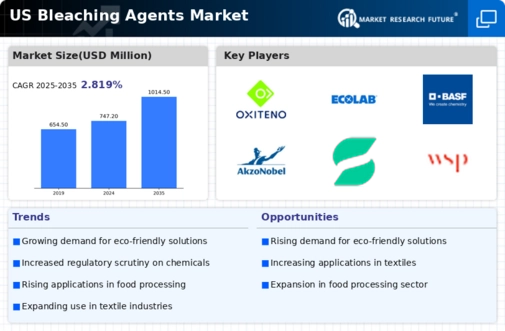Increased Regulatory Scrutiny
Increased regulatory scrutiny surrounding chemical products is influencing the bleaching agents market. Regulatory bodies are implementing stricter guidelines to ensure safety and environmental compliance, which affects how bleaching agents are formulated and marketed. Companies must adapt to these regulations, which may involve reformulating products to eliminate harmful substances. This shift could lead to a rise in demand for compliant and safer bleaching agents, potentially reshaping market dynamics. As manufacturers navigate these regulatory landscapes, the emphasis on transparency and safety is likely to become a key driver in the bleaching agents market.
Expansion of the Textile Industry
The expansion of the textile industry in the US is significantly impacting the bleaching agents market. As the demand for textiles continues to rise, particularly in the fashion and home furnishings sectors, the need for effective bleaching agents becomes paramount. The textile segment accounts for a substantial share of the bleaching agents market, with estimates suggesting it represents around 40% of total consumption. This growth is driven by the increasing production of synthetic fibers, which often require bleaching to achieve desired aesthetics. Consequently, the bleaching agents market is poised for growth as manufacturers seek to enhance product quality and meet consumer expectations.
Growth in the Personal Care Sector
The growth in the personal care sector is contributing to the expansion of the bleaching agents market. As consumers increasingly seek products that enhance their appearance, the demand for bleaching agents in cosmetics and personal care items is on the rise. This segment is expected to witness a CAGR of around 5% over the next few years, driven by trends in skin lightening and hair bleaching products. The personal care industry’s focus on innovative formulations and effective results is likely to propel the bleaching agents market forward, as manufacturers strive to meet evolving consumer preferences.
Innovations in Bleaching Technologies
Innovations in bleaching technologies are reshaping the bleaching agents market. Advances in chemical formulations and application methods are leading to more efficient and effective bleaching processes. For instance, the development of oxygen-based bleaching agents has gained traction due to their lower environmental impact compared to traditional chlorine-based options. These innovations not only improve the performance of bleaching agents but also align with the growing demand for safer and more sustainable products. As a result, companies investing in research and development are likely to gain a competitive edge in the bleaching agents market, catering to both industrial and consumer needs.
Rising Demand for Eco-Friendly Products
The increasing consumer preference for eco-friendly and sustainable products is driving the bleaching agents market. As awareness of environmental issues grows, consumers are seeking products that minimize ecological impact. This trend is particularly evident in the household cleaning and textile industries, where companies are reformulating products to include biodegradable bleaching agents. The market for eco-friendly bleaching agents is projected to grow at a CAGR of approximately 6% over the next five years. This shift not only reflects changing consumer values but also compels manufacturers to innovate and adapt their offerings to meet these demands, thereby influencing the overall dynamics of the bleaching agents market.



















Leave a Comment